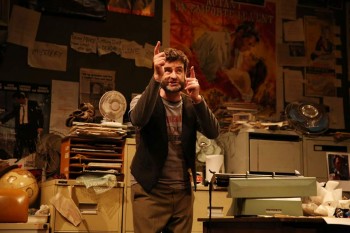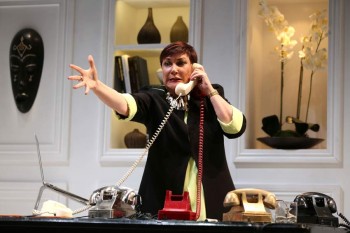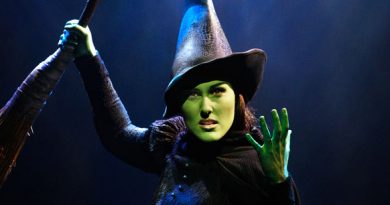The Pitch and The China Incident
Well, well, well, QTC, what a way to start 2013.

A double shot espresso through an intravenous drip injected straight into the veins of the audience are Peter Houghton’s one person, one-act plays The Pitch and The China Incident.
The Pitch, directed by Catarina Hebbard, is a turbo-charged farce from the point-of-view of a dishevelled writer, Walter Weinermann (played by Hugh Parker). He’s passionate to the point of being pathetic as he psyches himself up to pitch to a panel of executive producers in one hour; the only problem is – he doesn’t have an ending. In this hour-long monologue, Weinermann runs through his script one more time, casting as he goes. He re-lives his script and his characters in a way only a man with a strong vision can – complete with sound effects and physical commitment.
But every man has his weakness. He’s a basket case for his ex-wife and muse, Catherine, who fuels the tangled web of blurring between Weinermann’s imagination and reality. It’s interesting to think who he is really fighting for in the climactic battle scene where Weinermann morphs into Russell Crowe dodging grenades and bullets in slow motion to O Fortuna. I felt I was there with him but I was swiftly catapulted back into reality realising I was just watching a broken-hearted man essentially messing up his office.
Veteran actor, Hugh Parker, is a casting dream. His unbelievable ability to show us the truth in his acting is impeccable. It’s a testament to this fine actor’s work ethic and huge bag of technical tricks. He is inspirational and compelling to watch, role-playing within a role-play, seamlessly switching between characters, changing the pace and focus to keep the audience captivated. But, let’s face it, I would watch Parker just sit still for an hour – this man is hypnotic. But this work of writing art deserves a virtuoso to bring it to life – and that he certainly did. I wouldn’t be surprised if there are whispers for a Matilda Award.

Nearly equally as compelling to watch is Barbara Lowing embracing the character of Bea Pontivec in the one-woman show The China Incident.
Poised, organised and ball-busting, Bea is the Queen of Spin. She reigns her kingdom with a medley of phones connected to some very important people; The UN, the President and a ruthless dictator.
Self-assured and under control – Bea is efficient until her personal life interjects with some unexpected curve balls. Her ex-husband is a pansy, her son has been thrown in the slammer for drug trafficking and her daughter is having a meltdown over the plate selection in her wedding. Bea struggles to connect with her family, as her life as a PR consultant begins to unwind in a whirlwind of communication breakdown. While as an audience member, it was uncomfortable witnessing a woman’s nervous breakdown you couldn’t tear yourself away from her agony. Personally, at first I wasn’t connected with this character but as I saw her spiral into chaos, I couldn’t help but feel a little sorry for her. Unfortunately, the plot line was somewhat predictable but it was more with pure intrigue to see if Bea failed that kept me watching.
Lowing was believable and obviously invested in her character. She showed vulnerability within a character that seemed to be made of stainless steel. This made her mildly likeable amongst her plethora of unlikable traits. Also, technically, I think Lowing had a much more difficult task than Parker had in The Pitch. She executed the phone choreography with seamless conviction – it didn’t look contrived. This is a notable skill. It was evident the work that the director Daniel Evans, cast and crew needed to do to gel together an unassumingly technical production.
The set designs for both the plays were supreme contrasts of each other. Set designer, Simone Romaniuk, showed a wonderful understanding of storytelling through the use of props and design. Walter’s cluttered cave in The Pitch spun into Bea’s illuminated white office in The China Incident in record time. Bea’s office was complete with a drawer dedicated to perfectly stacked cigarettes at her fingertips. It’s this attention-to-detail that really encompassed the concept of “show, don’t tell”. Combine this with Ben Hughes’ lighting and Lawrence English’s sound composition, and you get two plays that draw you into their respective worlds with such intimate conviction.
Peter Houghton’s writing is witty and challenges the pitfalls of human behaviour. Both plays are packed with pop culture references most audience members can relate to with a little twist of lime to ordinarily-exhausted Hollywood clichéd plotlines. But I warn you, don’t take your eyes off the road, you’ll be left behind, particularly in The Pitch. Walter’s worlds collide with such great force it became difficult to differentiate between his real and fantasy lives.
Artistic Director of the Queensland Theatre Company, Wesley Enoch put it perfectly when he said, “it is a superhuman feat to carry the stage for an hour.” If anything, these two plays are a real showcase of what Queensland has to offer in the virtuosity of its actors and production potential.
The Pitch and The China Incident plays at the Cremorne Theatre, QPAC until March 9.


